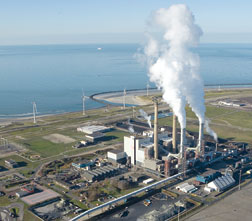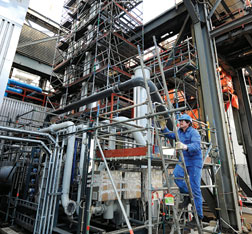
E.ON
E.ON’s Maasvlakte powerplant is testing a Dutch-developed CO2-capture technology.
|
In a program to reduce its carbon-dioxide emissions to half its 1990 level by 2030, the world’s largest investor-owned electric and gas utility is testing CO2-capture technologies from around the world at seven different sites. The program will run through 2012 on flue-gas streams from 0.1-MW to 7-MW plants. By 2020, the utility expects to be using carbon capture and storage on all its new coal-fired powerplants.
E.ON AG, Dusseldorf, Germany, is investing more than $81.5 million in the projects, says Clemens Tauber, E.ON spokesman. “With these small pilot plants, we will test and improve scrubbing processes. CO2 storage will be the subject in a next step. With a larger pilot plant of several tens of megawatts electric, we will demonstrate the full chain of capture, transport and storage. Startup of this larger plant is foreseen for 2014.”
The Electric Power Research Institute, Palo Alto, Calif., is working with companies throughout the world on research and development of CO2 capture technologies, says Stu Dalton, EPRI’s director of generation. “As yet, there’s no absolutely clear winner,” he adds. More than 30 companies are cofunding the 1.7-MW-equivalent project at We Energies’ Pleasant Prairie powerplant in Wisconsin to establish proof of concept for France-based Alstom’s chilled ammonia capture system. The pilot entered operation in February 2008. “What is unique [about E.ON’s program] is the breadth of technologies that one company has supported” for post-combustion testing, he says.
In July, E.ON and Fluor Corp., Irving, Texas, entered into an agreement to retrofit E.ON’s 747-MW coal-fired powerplant in Wilhelmshaven, Germany, with a pilot plant using Fluor’s Econamine FG+ carbon-capture technology. This will be the first demonstration on a coal-fired powerplant, Fluor officials say. “There was no market” for the technology on coal plants before, says Don Broeils, Fluor vice president for plant betterment.
The Wilhelmshaven pilot will be designed for a flue-gas volume flow of 16,000 cu meters per hour. “There’s not any significant modification to the process” to adapt it for the plant, says Broeils. “The CO2 concentration in coal flue gas is higher than in natural gas,” requiring “some tweaks to the process,” he says.

E.ON
Maasvlakte pilot treats 5 MW.
|
The Netherlands Organization for Applied Scientific Research (TNO) designed, constructed and is operating a postcombustion pilot at E.ON Benelux’s Maasvlakte powerplant near Rotterdam. It is testing solvents and membrane contactors developed by TNO. The absorption liquid used in the process is an amino acid salt trade-named CORAL. It began operation in April on 5% of the 1,040-MW plant’s flue gas stream.
Next summer, Cansolv Technologies Inc., Montreal, will deliver modules to E.ON’s 920-MW Heyden powerplant near Minden, Germany. Cansolv offers a competing amine-based capture technology whose parasitic load on the host plant is “almost nondetectable,” about 20%, says Colin Ryan, Cansolv vice president.
Amine and ammonia both are nitrogen compounds that have an affinity for CO2, says EPRI’s Dalton. Amines capture CO2 more easily, and ammonia’s advocates claim it releases CO2 more easily, he says. Many amine-based technologies have been developed, but ammonia may be pulling ahead. Powerspan Corp., Portsmouth, N.H., has two contracts for commercial demonstrations of its ammonia-based ECO2 technology, one at 120 MW and the other at 125 MW.

---Urban-Mining-Industries-Pozzotive_ENRready.jpg?height=200&t=1663257031&width=200)

Post a comment to this article
Report Abusive Comment